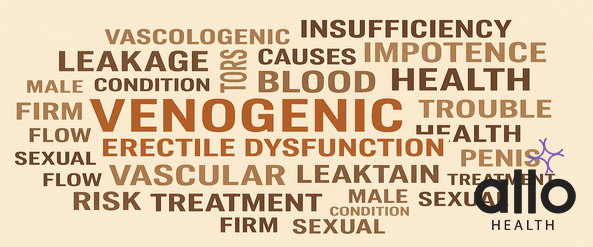What is Venogenic Erectile Dysfunction? Causes, Symptoms and Treatment Options

Venogenic erectile dysfunction (also called venous leak) is a type of physical erectile dysfunction where the veins in the penis fail to trap blood, leading to weak or erections, even when blood flow into the penis is normal. This condition often goes unnoticed in men who don’t respond well to ED pills. Causes may include age-related vein weakness, diabetes, high blood pressure, Peyronie’s disease, or past pelvic surgeries. Common signs are loss of firmness, morning and night erections that fade quickly. Diagnosis involves tests like Doppler ultrasound and CT cavernosography to locate the leaking veins. Treatment ranges from lifestyle changes and injections to advanced options like venous embolization, which seals the leaks with high success rates. Early detection and choosing the right treatment with your doctor can significantly improve erections and restore sexual confidence.
Erectile dysfunction (ED) is a condition when a man has trouble getting or keeping an erection firm enough for sexual activity. It’s more common than you might think ,affecting nearly 30 million men around the world [1]
ED can happen for many reasons. These may include vascular issues (like poor blood flow), neurological problems, hormonal imbalances, or even psychological stress, anxiety, or depression.
One lesser known but important type of physical ED is called venogenic erectile dysfunction, also known as veno-occlusive insufficiency and vasculogenic impotence. In this condition, the arteries bring blood into the penis normally, but the veins fail to trap and hold that blood. This causes the erection to fade too quickly. This can feel very frustrating for men and their partners.
In this article, we’ll break down venogenic ED in simple terms like what it is, what causes it, common symptoms, how it’s diagnosed, and the treatment options available.
What Is Venogenic Erectile Dysfunction?
Venogenic ED is a type of erectile dysfunction that happens when the veins in the penis can’t hold enough blood to keep an erection going. This condition is also called veno-occlusive disease or insufficiency [2].
In this condition, blood flow to the penis can be normal, but still the blood can leak out through the veins.
But how is this different from a normal erection? Let’s break it down [3]
In a normal erection:
- Blood flows into the penis through the penile arteries
- The penis fills up and becomes firm
- This pressure inside the penis compresses the veins to store the blood inside them.
But in venogenic ED, the veins don’t get compressed and shut properly, so blood leaks out. And when that happens, it becomes difficult to maintain the erection.
Think of the penis like a balloon that fills with air. In a healthy erection, the balloon fills and stays inflated. But in venogenic ED, it’s like the balloon has tiny holes, air goes in, but it slowly leaks out. So, the balloon can’t stay firm. That’s what happens when the veins in the penis can’t trap blood properly.

What Causes Venogenic ED?
Looking up what causes venogenic erectile dysfunction isn’t very easy because the exact cause is not known [4].
However, researchers have noticed that several risk factors are commonly seen in men with venogenic ED. These factors include:
Age:
The risk of venogenic ED increases with age. It’s more common in older men, likely because as we age, our veins lose elasticity and become weaker. When this happens, the veins may not be able to store blood properly during an erection. In fact, venogenic ED affects around 10 to 20% of men over 60 years old who struggle to get erections firm enough for penetration [5]
Diabetes and High Blood Pressure:
Men with conditions like diabetes or high blood pressure often have damaged blood vessels and tissues. This damage can affect veins throughout the body, including those in the penis, leading to venogenic ED [4]
Cardiovascular Diseases:
Heart-related problems affect blood circulation in the entire body, including the penis. If the blood isn’t circulating properly, it becomes harder for the penis to trap blood during an erection.
Peyronie’s disease :
This condition causes scar tissue to form inside the penis, which can interfere with blood flow and the normal erection process [3]
Pelvic Surgeries or Trauma:
Surgeries like radical prostatectomy or androgen deprivation therapy, often done for prostate issues or cancer, can damage the veins and nerves around the penis. This may make it harder to get or maintain erections [4]
Other Contributing Factors:
Apart from these, the usual causes of regular ED can also play a role in venogenic ED. For example:
Mental health issues like stress, anxiety, or depression can affect sexual response.
- Testosterone deficiency can also lead to erection problems, since this hormone plays a key role in sexual function.
While these may not directly damage the veins, they can still affect the body’s ability to maintain an erection.

Clinical Insights from Allo Health
Key Statistics from 250,000+ Patient Consultations:
- 47% of men with venogenic ED symptoms initially tried oral medications for 6+ months before seeking specialized diagnosis
- Only 23% of patients with venous leak responded adequately to PDE-5 inhibitors alone
- 78% of men under 40 with venogenic ED had additional psychological factors affecting their sexual performance
- 92% success rate achieved with endovascular embolization in our treatment program
Age-Related Patterns (Based on Allo Health Clinical Data):
- Men 25-35: Venogenic ED often combined with performance anxiety (68% of cases)
- Men 36-45: Higher correlation with work stress and lifestyle factors (54% of cases)
- Men 46-60: More likely to have underlying cardiovascular risk factors (71% of cases)
What Are the Symptoms of Venogenic ED?
The symptoms of venogenic ED are quite similar to those of regular erectile dysfunction. But there are a few signs that are more commonly linked with venous leakage [3]
Some symptoms you may notice include:
- Erections that last only for a short time
- Loss of morning or nighttime erections
- Loss of firm erections
These symptoms can make sexual activity unsatisfying, which over time can affect self-confidence, relationships, and overall quality of life [6]

How is Venous Leak Erectile Dysfunction Diagnosed?
Diagnosing vasculogenic impotence isn’t like a routine checkup. The symptoms often look similar to regular erectile dysfunction, so doctors need to find the root cause behind the condition. There is an International Index of Erectile Function questionnaire which every patient has to undergo before and after treatment.
Here’s what a person can usually expect during diagnosis for venous leak ED:
Personal and Medical History:
The first step is usually a detailed discussion. Doctors will ask about your medical background, lifestyle, mental health, and any past surgeries. This helps them to rule out psychological, hormonal, or physical causes of ED that may be causing venous leak ED too.
Doppler Ultrasound:
This is the first test used to suspect venogenic ED. A medication called prostaglandin E1 is injected into the penis to cause an erection [7]
Then, penile ultrasound imaging is done to measure three things [8]
- Peak Systolic Velocity (PSV): how fast blood enters the penis
- End-Diastolic Velocity (EDV): how fast blood leaks out
- Resistive Index (RI): how well the veins hold the blood in
The test indicates that a person is suffering from venogenic ed if the results [7] show:
PSV > 25 cm/s, EDV > 5 cm/s and RI < 0.75 (after 5 minutes).
Cavernosometry and Cavernosography:
Dynamic infusion cavernosometry and cavernosography have become the gold standard for detecting venogenic ed [8]. These tests are used in the cases where doppler ultrasound isn’t suitable like in people with penile implants, sickle cell disease, or some other medical conditions.
The procedure that these diagnosticc tools follow is:
- First, an erection is triggered using medication
- Then, fluid is slowly injected to measure pressure inside the penis
- After that, a contrast dye is injected, and X-ray images are taken
- This helps doctors visually locate exactly where the blood is leaking from the veins [7]
Computed Tomography Cavernosography:
When Doppler ultrasound suggests venogenic ed, doctors may also recommend a Computed Tomography Cavernosography (CT cavernosography). This is a detailed imaging test that gives a 3D view of the superficial, intermediate, and deep veins of the penile veins.
It helps doctors to see the exact site of venous leakage and understand the type of veins involved. This test also decides the criteria for treatment that needs to be done [7]
What Is the Best Venogenic Erectile Dysfunction Treatment?
There are several treatment options available for venogenic erectile dysfunction. But the right one depends on your diagnosis and overall condition. Your healthcare provider will help decide which venogenic ed treatment option suits you best.
Lifestyle Changes:
Lifestyle modifications can improve venogenic ED to some extent. These include:
- Getting regular exercise
- Eating a balanced diet
- Maintaining a healthy body mass index (BMI)
- Quitting smoking
These habits can improve penile venous leakage and support overall vascular health [3]
Oral Medications (phosphodiesterase-5 inhibitors):
Just like regular ED, doctors may first try PDE-5 inhibitor like sildenafil (Viagra) or tadalafil (Cialis). But in venous leak cases, these drugs often don’t work well because the issue isn’t blood flowing in, but blood leaking out [3]
Vacuum Erectile Devices (VEDs):
These devices use suction to pull blood into the penis. A tight ring is placed at the base to help trap the blood and prevent it from leaking out. It’s a non-surgical method, but some men may find it uncomfortable and unnatural [2]
Penile Injection Therapy or Intracavernosal Injections:
These injections are directly injected into the penis. They can create stronger erections than pills and may help manage venous leak symptoms, especially when oral medications fail.
Endovascular Venous Embolization (Minimally Invasive):
This is one of the most successful and commonly used treatments for venogenic ED today. A healthcare professional uses a thin catheter to reach the leaking penile veins and seals them using medical glue or solution. The benefits that come along with this type of endovascular therapy are:
- It’s a quick procedure
- No major surgery is needed. Success rates are over 97% and complication rates are very low—around 5%. [9]
Surgical Ligation:
This is an old traditional method of penile veins ligation where a surgeon ties off the leaking veins. It’s more invasive than embolization and has a lower long-term success rate.Penile Implants: This surgical treatment option is considered only when other treatments fail. A device is placed inside the penis (in the corpora cavernosa), allowing a man to get an erection when desired.
There’s no guaranteed cure for venogenic ED, but many men see significant improvement, especially with embolization. The key is proper diagnosis and working closely with your doctor to find the best treatment path.

What Do The Numbers At Allo Health Say?
We’ve spoken to thousands of men across India who thought their ED was untreatable. After 15,000+ consultations at Allo Health, we have uncovered some clear patterns behind venogenic ED.
- 42% of men with venogenic ED tried oral pills for over 3 months before seeking help.
- Only 1 in 4 responded well to PDE-5 inhibitors alone
- 7 in 10 men under 40 also faced psychological factors like performance anxiety
- 90% success rate seen with endovascular embolization in eligible cases
Age Patterns We Noticed:
- Ages 25–35: Performance anxiety common (65% of cases)
- Ages 36–45: Lifestyle stressors more common (50%)
- Ages 46–60: Most had heart risk factors (70%)
Final Words
Venogenic ed is more common than many people realize. If your erections start strong but fade too soon, or if you’ve lost your morning or nighttime erections, you may be experiencing a venogenic ED. But the good news is that, due to advanced diagnostic tools and effective treatment options a lot of men can still regain long lasting erections. Early diagnosis and proper treatment can help you restore your sexual health and confidence.
Many men with venogenic erectile dysfunction feel frustrated when ED medications don’t help. That’s often because the problem isn’t blood flow, but it’s blood leaking out too soon. With proper tests like Doppler ultrasound and computed tomography cavernosography, we can identify the leak and guide them toward targeted treatments.
"The following blog article provides general information and insights on various topics. However, it is important to note that the information presented is not intended as professional advice in any specific field or area. The content of this blog is for general educational and informational purposes only.
Book consultation
The content should not be interpreted as endorsement, recommendation, or guarantee of any product, service, or information mentioned. Readers are solely responsible for the decisions and actions they take based on the information provided in this blog. It is essential to exercise individual judgment, critical thinking, and personal responsibility when applying or implementing any information or suggestions discussed in the blog."






